 |
| 1 |  | 
Find the maximum or minimum of y = 3x2 -12x + 8. |
|  | A) | (-2, -4) |
|  | B) | (2, -4) |
|  | C) | (2, 4) |
|  | D) | (-2, 4) |
|
|
 |
| 2 |  | 
In the standard viewing window shown
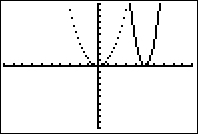 <a onClick="window.open('/olcweb/cgi/pluginpop.cgi?it=jpg::::/sites/dl/free/0070780846/506629/FFCM11_PracticeExam45_question2.jpg','popWin', 'width=NaN,height=NaN,resizable,scrollbars');" href="#"><img valign="absmiddle" height="16" width="16" border="0" src="/olcweb/styles/shared/linkicons/image.gif"> (7.0K)</a> <a onClick="window.open('/olcweb/cgi/pluginpop.cgi?it=jpg::::/sites/dl/free/0070780846/506629/FFCM11_PracticeExam45_question2.jpg','popWin', 'width=NaN,height=NaN,resizable,scrollbars');" href="#"><img valign="absmiddle" height="16" width="16" border="0" src="/olcweb/styles/shared/linkicons/image.gif"> (7.0K)</a>
the graph of is shown as a dotted parabola and the graph of a relation of the form is shown as a solid parabola. Which of the following correctly categorize the values of a and h? |
|  | A) | a > 1
h < 0 |
|  | B) | a < 1
h > 0 |
|  | C) | a > 1
h > 0 |
|  | D) | a > 1
h = 0 |
|
|
 |
| 3 |  | 
Describe the transformations that would be applied to the graph of to obtain the graph of . |
|  | A) | Translated one unit to the left and two units up, then stretched. |
|  | B) | Translated one unit to the left and two units up, then compressed. |
|  | C) | Translated one unit to the right and two units up. |
|  | D) | Translated one unit to the left and two units up. |
|
|
 |
| 4 |  | 
Which of the following could be the equation for the graph shown:
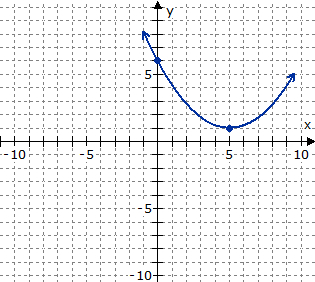 <a onClick="window.open('/olcweb/cgi/pluginpop.cgi?it=jpg::::/sites/dl/free/0070780846/506629/FFCM11_PracticeExam45_question5.jpg','popWin', 'width=NaN,height=NaN,resizable,scrollbars');" href="#"><img valign="absmiddle" height="16" width="16" border="0" src="/olcweb/styles/shared/linkicons/image.gif"> (75.0K)</a> <a onClick="window.open('/olcweb/cgi/pluginpop.cgi?it=jpg::::/sites/dl/free/0070780846/506629/FFCM11_PracticeExam45_question5.jpg','popWin', 'width=NaN,height=NaN,resizable,scrollbars');" href="#"><img valign="absmiddle" height="16" width="16" border="0" src="/olcweb/styles/shared/linkicons/image.gif"> (75.0K)</a> |
|  | A) | y = 1/5(x - 5)2 + 1 |
|  | B) | y = 1/5(x + 5)2 + 1 |
|  | C) | y = 5(x - 5)2 + 1 |
|  | D) | y = 1/5x2 - 2x + 5 |
|
|
 |
| 5 |  | 
Which of the following is the graph of y = 3(x - 1)2 + 2? |
|  | A) | 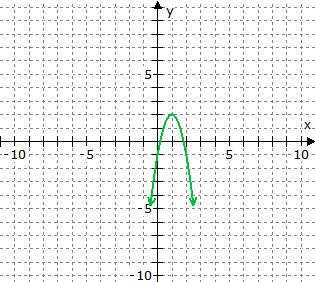 <a onClick="window.open('/olcweb/cgi/pluginpop.cgi?it=jpg::::/sites/dl/free/0070780846/506629/FFCM11_PracticeExam45_question6a.jpg','popWin', 'width=NaN,height=NaN,resizable,scrollbars');" href="#"><img valign="absmiddle" height="16" width="16" border="0" src="/olcweb/styles/shared/linkicons/image.gif"> (74.0K)</a> <a onClick="window.open('/olcweb/cgi/pluginpop.cgi?it=jpg::::/sites/dl/free/0070780846/506629/FFCM11_PracticeExam45_question6a.jpg','popWin', 'width=NaN,height=NaN,resizable,scrollbars');" href="#"><img valign="absmiddle" height="16" width="16" border="0" src="/olcweb/styles/shared/linkicons/image.gif"> (74.0K)</a>
|
|  | B) | 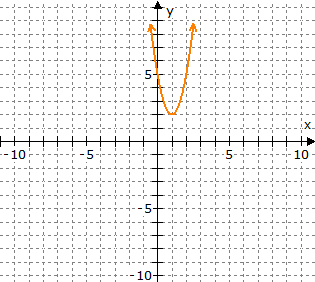 <a onClick="window.open('/olcweb/cgi/pluginpop.cgi?it=jpg::::/sites/dl/free/0070780846/506629/FFCM11_PracticeExam45_question6b.jpg','popWin', 'width=NaN,height=NaN,resizable,scrollbars');" href="#"><img valign="absmiddle" height="16" width="16" border="0" src="/olcweb/styles/shared/linkicons/image.gif"> (74.0K)</a> <a onClick="window.open('/olcweb/cgi/pluginpop.cgi?it=jpg::::/sites/dl/free/0070780846/506629/FFCM11_PracticeExam45_question6b.jpg','popWin', 'width=NaN,height=NaN,resizable,scrollbars');" href="#"><img valign="absmiddle" height="16" width="16" border="0" src="/olcweb/styles/shared/linkicons/image.gif"> (74.0K)</a>
|
|  | C) | 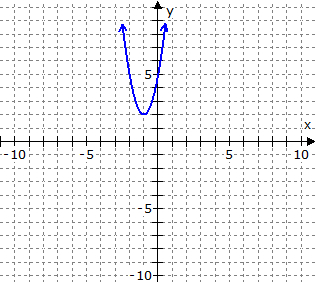 <a onClick="window.open('/olcweb/cgi/pluginpop.cgi?it=jpg::::/sites/dl/free/0070780846/506629/FFCM11_PracticeExam45_question6c.jpg','popWin', 'width=NaN,height=NaN,resizable,scrollbars');" href="#"><img valign="absmiddle" height="16" width="16" border="0" src="/olcweb/styles/shared/linkicons/image.gif"> (74.0K)</a> <a onClick="window.open('/olcweb/cgi/pluginpop.cgi?it=jpg::::/sites/dl/free/0070780846/506629/FFCM11_PracticeExam45_question6c.jpg','popWin', 'width=NaN,height=NaN,resizable,scrollbars');" href="#"><img valign="absmiddle" height="16" width="16" border="0" src="/olcweb/styles/shared/linkicons/image.gif"> (74.0K)</a>
|
|  | D) | 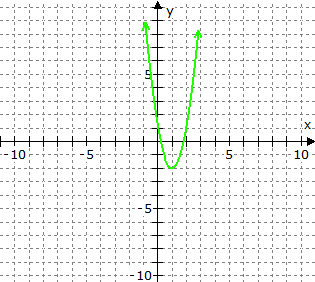 <a onClick="window.open('/olcweb/cgi/pluginpop.cgi?it=jpg::::/sites/dl/free/0070780846/506629/FFCM11_PracticeExam45_question6d.jpg','popWin', 'width=NaN,height=NaN,resizable,scrollbars');" href="#"><img valign="absmiddle" height="16" width="16" border="0" src="/olcweb/styles/shared/linkicons/image.gif"> (75.0K)</a> <a onClick="window.open('/olcweb/cgi/pluginpop.cgi?it=jpg::::/sites/dl/free/0070780846/506629/FFCM11_PracticeExam45_question6d.jpg','popWin', 'width=NaN,height=NaN,resizable,scrollbars');" href="#"><img valign="absmiddle" height="16" width="16" border="0" src="/olcweb/styles/shared/linkicons/image.gif"> (75.0K)</a>
|
|
|
 |
| 6 |  | 
Find the x-intercept(s) of y = -2x2 - 24x - 72 |
|  | A) | -8 and -6 |
|  | B) | -6 and 6 |
|  | C) | 6 |
|  | D) | -6 |
|
|
 |
| 7 |  | 
Find the y-intercept(s) of y = 1/8(x - 4)2 + 3. |
|  | A) | 5 |
|  | B) | 3 |
|  | C) | 1/8 |
|  | D) | -4 |
|
|
 |
| 8 |  | 
Expand fully: (t + 3)(4t - 2) |
|  | A) | 4t2 - 6 |
|  | B) | 4t2 - 10t - 6 |
|  | C) | t2 + 10t - 6 |
|  | D) | 4t2 + 10t - 6 |
|
|
 |
| 9 |  | 
Expand fully: (3x - 5)2 |
|  | A) | 9x2 + 25 |
|  | B) | 9x2 - 30x + 25 |
|  | C) | 9x2 + 30x + 25 |
|  | D) | 9x2 - 30x - 25 |
|
|
 |
| 10 |  | 
Expand fully: (5g - 4h)(5g + 4h) |
|  | A) | 25g2 - 40gh + 16h2 |
|  | B) | 25g2 + 40gh + 16h2 |
|  | C) | 25g2 + 16h2 |
|  | D) | 25g2 - 16h2 |
|
|
 |
| 11 |  | 
Find an expression for the area of the rectangle shown:
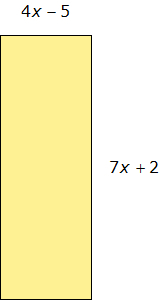 <a onClick="window.open('/olcweb/cgi/pluginpop.cgi?it=jpg::::/sites/dl/free/0070780846/506629/FFCM11_PracticeExam45_question11.jpg','popWin', 'width=NaN,height=NaN,resizable,scrollbars');" href="#"><img valign="absmiddle" height="16" width="16" border="0" src="/olcweb/styles/shared/linkicons/image.gif"> (9.0K)</a> <a onClick="window.open('/olcweb/cgi/pluginpop.cgi?it=jpg::::/sites/dl/free/0070780846/506629/FFCM11_PracticeExam45_question11.jpg','popWin', 'width=NaN,height=NaN,resizable,scrollbars');" href="#"><img valign="absmiddle" height="16" width="16" border="0" src="/olcweb/styles/shared/linkicons/image.gif"> (9.0K)</a> |
|  | A) | 28x2 - 43x - 10 square units |
|  | B) | 28x2 - 27x + 10 square units |
|  | C) | 28x2 - 27x - 10 square units |
|  | D) | 28x2 - 10 square units |
|
|
 |
| 12 |  | 
Write the equation in standard form of the parabola with maximum at (2, 3) with x-intercepts at 0 and 4. |
|  | A) | y = -0.75x2 + 3x |
|  | B) | y = -0.75x2 - 3x |
|  | C) | y = -1/3x2 + 4/3x + 5/3 |
|  | D) | y = -3/4x2 + 3x - 6 |
|
|
 |
| 13 |  | 
Factor fully: -6x2 - 42x - 72 |
|  | A) | -6(x2 + 7x + 12) |
|  | B) | -6(x + 2)(x + 6) |
|  | C) | -6(x + 3)(x + 4) |
|  | D) | -6(x + 1)(x + 12) |
|
|
 |
| 14 |  | 
Find the height and base of the shaded region shown, assuming there are no fractions among the coefficients of the expressions for the dimensions.
 <a onClick="window.open('/olcweb/cgi/pluginpop.cgi?it=jpg::::/sites/dl/free/0070780846/506629/FFCM11_PracticeExam45_question14.jpg','popWin', 'width=NaN,height=NaN,resizable,scrollbars');" href="#"><img valign="absmiddle" height="16" width="16" border="0" src="/olcweb/styles/shared/linkicons/image.gif"> (18.0K)</a> <a onClick="window.open('/olcweb/cgi/pluginpop.cgi?it=jpg::::/sites/dl/free/0070780846/506629/FFCM11_PracticeExam45_question14.jpg','popWin', 'width=NaN,height=NaN,resizable,scrollbars');" href="#"><img valign="absmiddle" height="16" width="16" border="0" src="/olcweb/styles/shared/linkicons/image.gif"> (18.0K)</a> |
|  | A) | x2 cm, x + 16 cm |
|  | B) | x + 1 cm, x + 16 cm |
|  | C) | x + 4 cm, x + 4 cm |
|  | D) | x + 2 cm, x + 8 cm |
|
|
 |
| 15 |  | 
The popularity of the pop band Delixious can be modelled by the equation P = 900d - 2d2, where P is the number Delixious fans and d is the number of days from their first performance. How many fans will Delixious have at their peak of popularity? |
|  | A) | 225 |
|  | B) | 101 250 |
|  | C) | 151 875 |
|  | D) | 500 625 |
|
|

